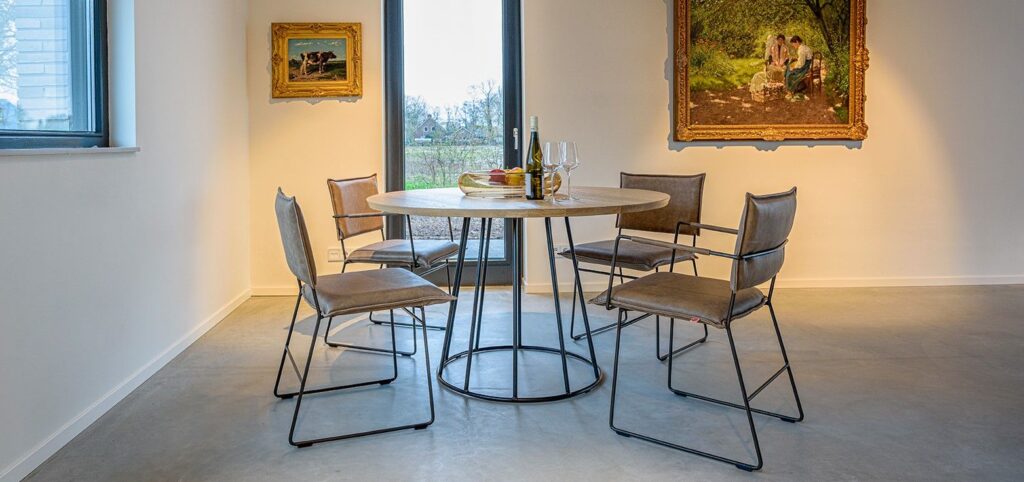

By Evan I.
There are numerous types of leather – so many that it can be confusing and overwhelming to figure out what each kind offers and the differences between them!
A lot of factors go into determining whether a certain kind of leather is high-quality or not. Most of us tend to think that higher value leathers are more natural, and lower value leathers are less natural. Price and quality can vary, though, due to the leather’s source, type, and thickness.
Here, we’ll talk about the leather continuum from less to more processed leather so that you can figure out which type of leather is best for you. Here’s the definitive guide to the different types of leather available at Copenhagen!
Aniline leather, named for the type of dye used in making it, is at the top of the “natural” side of the leather spectrum. It is the least processed type of leather, making it the closest you can get to a raw hide!
Aniline leather is made from extremely high-quality hides, and is dyed with a natural, soluble dye. The use of a light dye means that the organic qualities of the leather, like color and texture variance, marks, scars, and differences in the grain, are still visible. These markings add to the beauty of the leather and make each piece unique.
Some aniline leathers might have an oil or a wax added to give it a “pull-up” effect. In the Copenhagen collection, both the Norman Side Chair, available in cognac Luxor leather, and the Mayfair Large Chair and Ottoman, available in grey Pioneer leather, are aniline leathers with the pull-up effect. Both leathers have waxes or oils applied to achieve a leather that is soft, smooth and somewhat shiny.
Aniline leathers like the Luxor and the Pioneer leathers are a good choice if you’re looking for a genuine, high-quality leather with a weathered look. “Aniline leather is for the true leather connoisseur,” says Dave, a sales associate at Copenhagen. “It lets you know immediately that it’s real leather.”
Aniline leathers wear beautifully and naturally over time. They can be sensitive to stains, scratches, and sunlight, but the leather also develops character and patina as it ages. Proper care will ensure the longevity of aniline leathers for years to come.
Semi-aniline leather, like the name implies, is very similar to aniline leather. Semi-aniline leather goes through the same processes as aniline leather but is lightly pigmented and finished with a light lacquer. This gentle protective treatment helps protect the leather from mild wear and tear. Other than their light topcoat, semi-aniline leathers are unaltered and will also show any color and texture variance, marks, scars, and differences in the grain that are present in the hide.
In the Copenhagen collection, the Stella Sofa in Oxford Blue Paloma leather and the Assago Sectional in grey Nevada leather use semi-aniline leather. Semi-aniline pieces like these are a great in-between choice. They are family-friendly, easy to clean, and can be placed in high-traffic or even commercial areas, but they also have all the benefits of a fully natural leather.
Corrected leather is leather that is, you guessed it, “corrected” with dyes to smooth out imperfections, and it is also more heavily protected than aniline and semi-aniline leathers. Corrected leathers frequently have natural marks removed, are more heavily pigmented to ensure color consistency, and are grain-embossed for a more uniform look. Layers of protective treatment are also applied.
In the Copenhagen collection, the Turro Chair in carmel Royal leather and the Consul Large Chair and Ottoman in brown Batick leather are both corrected leathers.
This leather is much more resistant to heavy wear and tear such as sunlight, spills, and scratches, is family-friendly, and does well in high-traffic and commercial areas, or anywhere where substantial and consistent use is likely. And for those with pets at home, corrected, protected leather is less likely to show wear and scratch marks, though depending on the pet, it’s not a guarantee!
The heavily protected surface means that it loses some of the qualities of an aniline or semi-aniline leather, like softness and breathability. However, corrected leather is a good choice if you want a leather that is low-maintenance and easy to care for.
Bonded leather is made with re-used, leftover pieces of leather, combined with synthetic material. Since it isn’t a true natural leather, bonded leather does not wear organically over time. It also likely won’t last as long as 100% leather that is high-quality, like the other kinds of leather higher up on the continuum. As long as you’re aware of this, however, bonded leather is cost-effective and can look great. It is often used on pieces that commonly see heavy use and have a high potential for staining and damage, such as dining chairs. Both the Emma Chair and the Vera Desk Chair are upholstered in bonded leather for a sophisticated look at a lower price.
Artificial leather, also known as synthetic leather, vegan or “eco” leather, and by many other names, isn’t actually leather, but it has a spot on this list anyway. This leather substitute, typically made with fabric and synthetic materials, has the same benefits as bonded leather: it’s less expensive than real leather, and can imitate the aesthetic of real leather at a lower cost. However, it also has some of the same downsides in terms of durability. Nevertheless, artificial leather can be a great and economical choice if real leather isn’t your thing. The Gaia line of chairs, available as a dining chair, lounge chair, barstool and counter stool, is made from high-quality artificial leather that provides chic style with little need for maintenance.
Leather is an incredibly versatile material, and can bring your home style, comfort, and quality. To find all these products (and more!) visit us online or at a Copenhagen location near you. Still have questions? You can also contact us here.